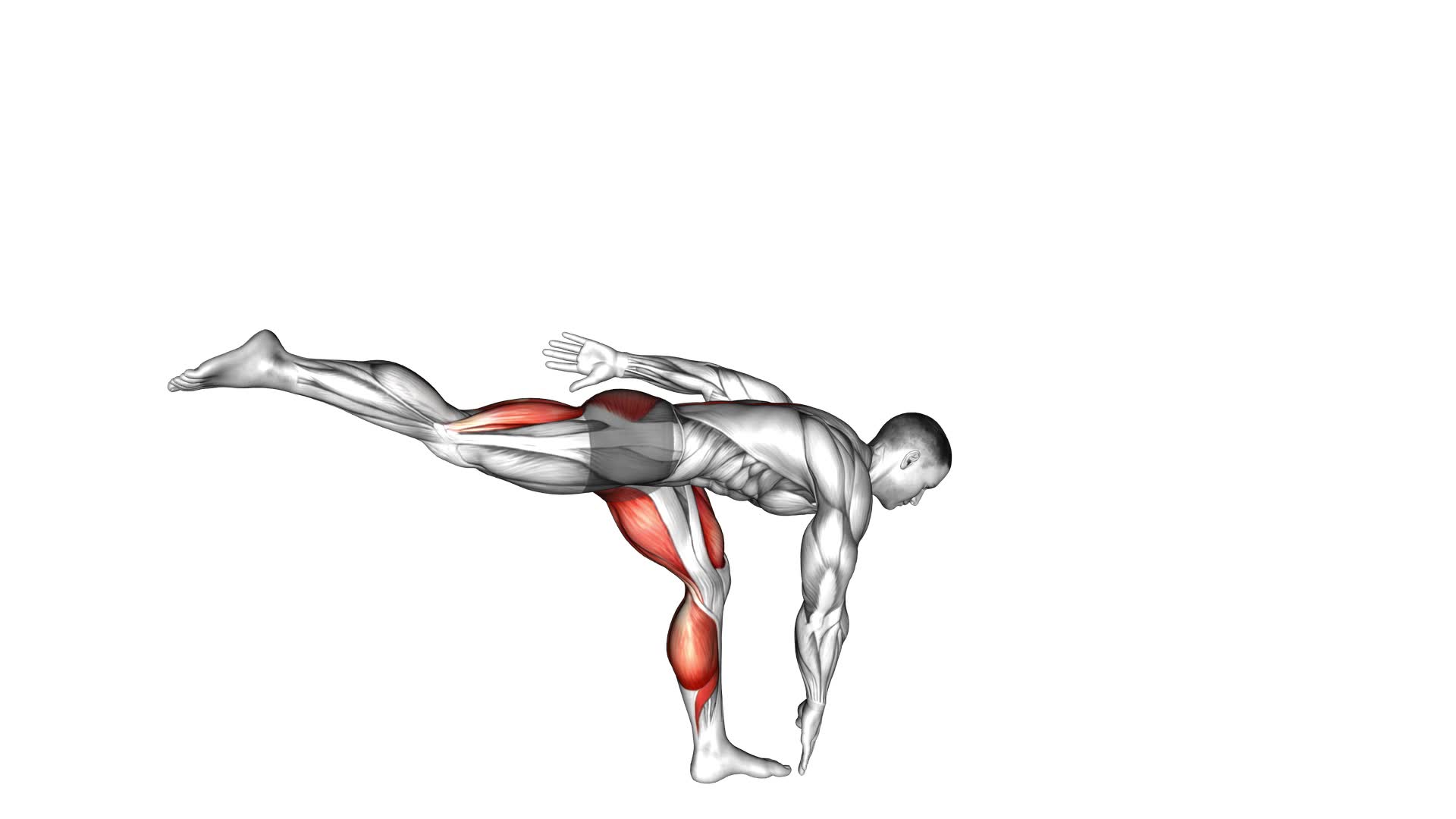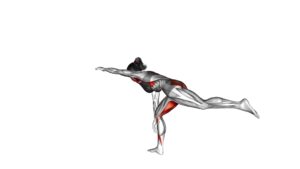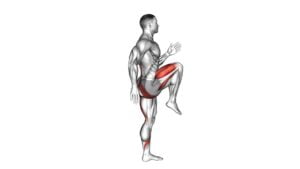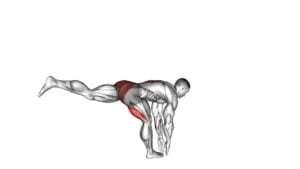Bodyweight Single Leg Deadlift – Video Exercise Guide & Tips

Are you looking to strengthen your lower body and improve balance? The bodyweight single leg deadlift is the perfect exercise for you.
Watch This Exercise Video
In this video exercise guide, we will show you the proper form and technique to perform this challenging move.
You'll also learn common mistakes to avoid and get tips for maximizing the exercise.
Get ready to take your fitness to the next level with the bodyweight single leg deadlift.
Let's get started!
Key Takeaways
- Targets multiple muscle groups simultaneously (glutes, hamstrings, lower back)
- Improves balance, stability, and coordination
- Strengthens the core
- Offers versatility with various variations and modifications
Benefits of Bodyweight Single Leg Deadlift
Discover the numerous benefits you can reap from incorporating the bodyweight single leg deadlift into your workout routine. This exercise offers several advantages that can enhance your overall fitness level.
Firstly, the bodyweight single leg deadlift targets multiple muscle groups simultaneously, including the glutes, hamstrings, and lower back. By engaging these muscles, you can improve your balance, stability, and coordination. Additionally, this exercise helps to strengthen the core, as it requires a strong and stable midsection to maintain proper form.
Another benefit of the bodyweight single leg deadlift is its versatility. There are various variations of this exercise that can be adapted to suit your fitness goals and abilities. For instance, you can perform it with or without weights, depending on your strength level. Additionally, you can modify the range of motion to increase or decrease the difficulty. By incorporating these variations, you can continually challenge your muscles and prevent plateaus in your fitness progress.
Now that you're aware of the advantages and variations of the bodyweight single leg deadlift, it's crucial to ensure proper form and technique.
Proper Form and Technique
To ensure proper form and technique for the bodyweight single leg deadlift, it's important that you maintain a straight back and engage your core throughout the exercise. This will help you improve your balance and target your glute muscles effectively. Here are some key tips to help you perform the exercise correctly:
- Stand tall with your feet hip-width apart.
- Shift your weight onto one leg while keeping a slight bend in the knee.
- Slowly hinge forward at your hips, extending your non-weight-bearing leg straight behind you.
- Keep your back straight and your gaze focused on the ground to maintain balance.
- Engage your core muscles to stabilize your body throughout the movement.
- Lower your upper body until it's parallel to the ground, while simultaneously lifting your non-weight-bearing leg until it's in line with your body.
- Pause for a moment at the bottom of the movement, then slowly return to the starting position.
By following these tips, you'll ensure that you're performing the bodyweight single leg deadlift with proper form and technique, allowing you to maximize the benefits and avoid potential injuries.
Now, let's explore some common mistakes to avoid in order to further enhance your workout.
Common Mistakes to Avoid
Now let's go over some common mistakes you should avoid when performing the bodyweight single leg deadlift.
- One common mistake isn't maintaining proper balance throughout the movement. It's important to keep your core engaged and your body aligned from head to toe. Avoid leaning forward or backward excessively, as this can throw off your balance and put unnecessary strain on your lower back.
- Another mistake to avoid isn't keeping your working leg straight. Keep a slight bend in your knee to prevent hyperextension, but make sure your leg remains straight throughout the exercise. This will help engage your glutes and hamstrings properly.
- A common error is rushing through the movement. Take your time and focus on each repetition. Slow and controlled movements will engage the muscles more effectively and prevent any jerking or bouncing motions that can lead to injury.
- Lastly, avoid rounding your back during the exercise. Keep your spine neutral and maintain a straight line from your head to your tailbone. This will help protect your spine and ensure proper muscle activation.
Progressions and Modifications
To advance your bodyweight single leg deadlift, you can incorporate progressions and modifications into your routine. These techniques will help you challenge your muscles and continue to make progress.
Here are three ways to modify and progress the exercise:
- Add weight: Once you have mastered the bodyweight single leg deadlift, you can start adding weight to increase the intensity. Hold a dumbbell or kettlebell in the hand opposite to the leg you're standing on. This will further engage your core and target your glutes and hamstrings.
- Increase range of motion: As you become more comfortable with the exercise, you can work on increasing your range of motion. Try to lower your upper body closer to the ground while keeping your leg straight and back flat. This will require more flexibility and strength in your standing leg.
- Perform on an unstable surface: Another way to progress the bodyweight single leg deadlift is by performing it on an unstable surface, such as a balance board or foam pad. This will challenge your stability muscles and improve your overall balance and coordination.
Tips for Maximizing the Exercise
To maximize the effectiveness of the bodyweight single leg deadlift, consistently focus on maintaining proper form throughout each repetition. Proper form is crucial for targeting the right muscles and preventing injury. One common misconception is that you need to touch the ground with your hand during the movement. However, the goal is to maintain a straight line from your head to your back leg, so only go as low as you can while keeping your back straight. Another tip is to engage your core throughout the exercise. This will help stabilize your body and improve your balance.
There are also variations and alternatives to the bodyweight single leg deadlift that you can incorporate into your workout routine. One variation is the weighted single leg deadlift, where you hold a dumbbell or kettlebell in your hand as you perform the exercise. This adds resistance and makes the movement more challenging. Another alternative is the glute bridge, which targets similar muscles but with a different range of motion. To perform a glute bridge, lie on your back with your knees bent, lift your hips off the ground, and squeeze your glutes at the top of the movement.
Frequently Asked Questions
How Does the Bodyweight Single Leg Deadlift Target Different Muscle Groups Compared to the Traditional Deadlift?
The bodyweight single leg deadlift targets different muscle groups compared to the traditional deadlift. By focusing on one leg at a time, it engages the glutes, hamstrings, and core more intensely.
This exercise also improves balance and stability, as you have to rely on one leg for support.
The benefits of the bodyweight single leg deadlift include building strength and muscle endurance, improving posture, and reducing the risk of muscle imbalances and injuries.
Is It Safe to Perform the Bodyweight Single Leg Deadlift if I Have a History of Lower Back Pain?
If you have a history of lower back pain, it's important to approach the bodyweight single leg deadlift with caution. While this exercise can be beneficial for strengthening your glutes and hamstrings, it may put strain on your lower back if not performed correctly.
To prevent lower back pain, focus on maintaining a neutral spine throughout the movement and engage your core muscles for stability. If necessary, you can also modify the exercise by using a lower range of motion or reducing the amount of weight you lift.
Can the Bodyweight Single Leg Deadlift Help Improve Balance and Stability?
Performing the bodyweight single leg deadlift can help you improve balance and stability. This exercise specifically targets the muscles in your legs, hips, and core, which are essential for maintaining stability and balance.
By regularly incorporating this exercise into your routine, you can strengthen these muscles and improve your overall balance and stability.
It's important to start with proper form and gradually increase the difficulty level as you progress to ensure safety and effectiveness.
Are There Any Variations of the Bodyweight Single Leg Deadlift That Can Be Done With Equipment?
There are several variations of the bodyweight single leg deadlift that can be done with equipment. By incorporating equipment such as dumbbells or kettlebells, you can add resistance to the exercise and challenge your muscles even more.
Another option is using a stability ball or a BOSU ball to further engage your core and improve balance.
These variations provide a great way to progress and continue challenging yourself as you improve your strength and stability.
How Often Should I Incorporate the Bodyweight Single Leg Deadlift Into My Workout Routine to See Results?
To see results from the bodyweight single leg deadlift, it's important to incorporate it into your workout routine regularly. Consistency is key. Aim to do the exercise two to three times a week. This will give your muscles enough time to recover and grow stronger.
Conclusion
In conclusion, the bodyweight single leg deadlift is a highly effective exercise that targets the lower body muscles, improves balance, and enhances overall strength.
By following proper form and technique, avoiding common mistakes, and incorporating progressions and modifications, you can maximize the benefits of this exercise.
Remember to engage your core, keep your back straight, and focus on stability throughout the movement.
With consistency and dedication, you can achieve great results with the bodyweight single leg deadlift.

Author
Years ago, the spark of my life’s passion ignited in my mind the moment I stepped into the local gym for the first time. The inaugural bead of perspiration, the initial endeavor, the very first surge of endorphins, and a sense of pride that washed over me post-workout marked the beginning of my deep-seated interest in strength sports, fitness, and sports nutrition. This very curiosity blossomed rapidly into a profound fascination, propelling me to earn a Master’s degree in Physical Education from the Academy of Physical Education in Krakow, followed by a Sports Manager diploma from the Jagiellonian University. My journey of growth led me to gain more specialized qualifications, such as being a certified personal trainer with a focus on sports dietetics, a lifeguard, and an instructor for wellness and corrective gymnastics. Theoretical knowledge paired seamlessly with practical experience, reinforcing my belief that the transformation of individuals under my guidance was also a reflection of my personal growth. This belief holds true even today. Each day, I strive to push the boundaries and explore new realms. These realms gently elevate me to greater heights. The unique combination of passion for my field and the continuous quest for growth fuels my drive to break new ground.







